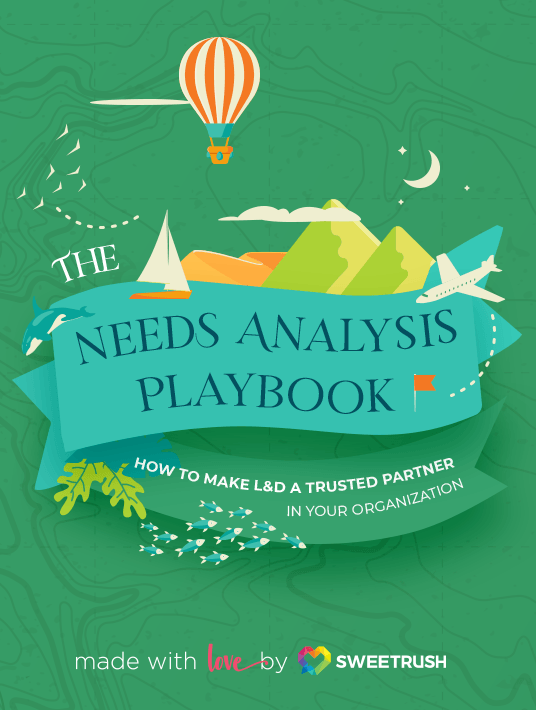Learning Needs Assessment Tips: Adopt A Consultant’s Mindset, Be A Trusted Partner
It’s a sad fact that, in challenging times, the L&D departments’ budgets and resources are often the first to be cut. L&D is still seen by many companies as a cost center and not a business partner. And when leaders and stakeholders can’t make the correlation between
their investment and the business results—if they can’t see the value that training provides—they cut costs.
In a recent survey conducted by the CEB, only 33% of business leaders think the L&D function impacts business outcomes, and fewer consider the function to be relevant or timely. [1]
That’s an alarming statistic.
So how do we win over the other 67%? How do we show stakeholders and members of the C-suite that L&D is relevant? How can L&D managers ensure that our function is seen as a trusted partner instead of a resource? Furthermore, how do we get that all-important buy-in?
Read on as I answer these questions and more with my three steps for getting buy-in for your vision.

Step 1: Adopt a Consultant's Mindset

Stakeholders aren’t learning professionals and so they often come to L&D with solutions or wants—“The northeast sales team needs a refresher course on the CRM training”—instead of problems and needs.
It would be easy for L&D managers to adopt an order-taker position in this example and give the stakeholders what they are asking for—after all, the request is pretty specific. But what if something else is impacting the northeast sales team’s performance? Would putting them through a CRM refresher course make a difference? It’s highly unlikely. And where would that leave L&D?
What the stakeholder wants and what the stakeholder needs are often two very different things. Your job as an L&D manager is to ensure your team can help them see the difference.
To do this, you need to step out of the order-taker mindset and become more consultative in your approach. You need to show stakeholders that L&D is a trusted partner as well as a valuable resource.
As you are working together, be open and curious and listen carefully to what the stakeholders have to say. Share your insights, offer your expertise, and don’t be afraid to push back when you need to.
Step 2: Involve Stakeholders in the Needs Assessment Process

Getting buy-in for your vision will be easier when stakeholders are involved and invested in the process. To be clear, they don’t need to participate in all of the needs assessment activities, but they should be kept informed about the steps you’re taking and why the process is important.
L&D managers need to conduct (or enable your teams to conduct) three main activities for the learning needs assessment: (1) stakeholder analysis, (2) learner audience analysis, and (3) analysis of the constraints. Here’s how and when to involve stakeholders throughout the process.
1. Stakeholder analysis
This is where you will uncover what is really driving the need, who it affects, what the desired outcomes are (what success looks like), how success will be measured and what, if anything, might impede or enable success. Above all, you’ll determine if training is the right—and only—solution.
Stakeholder involvement: High
Stakeholders should be fully involved and engaged in this process. This is their opportunity to tell you what is going on and to define what success looks like. No one else can do this for you.
For a full list of stakeholder analysis questions, see Chapter 1 of our new guide, The Needs Analysis Playbook.
2. Learner audience analysis
This is where you’ll gain a deep understanding of your learners’ wants and needs. You’ll build empathy with your learners as you discover what types of learning experiences engage and motivate them.
Stakeholder involvement: Low
You’ll need to ask stakeholders to identify a representative sample of learners you should meet with. Once you have your list, you’ll work directly with the learners.
Note: Some stakeholders may want to “help” you with this piece, but this is one place you don’t want stakeholders to be involved. They may tell you that they know the learners well and therefore know what the learners want and need. But the truth is, no one can tell you how learners like to learn but the learners themselves. Bring your full consultant self to the fore here, and gently push back on stakeholders who want to stand in for learners during this crucial step.
For more help with the learner audience analysis and pushing back on stakeholders, see Chapter 2 of our new guide, The Needs Analysis Playbook.
3. Analysis of the constraints
This is where you’ll map out the time, cost, and resources needed to complete your training project and anticipate the constraints you might face. You’ll also identify if and where you might be able to leverage or influence the constraints.
Stakeholder involvement: Low
If the stakeholder has a fixed set of constraints in mind, you’ll need to establish what these are before you analyze what you’ll actually need for your project. You will then conduct the analysis independently.
If the stakeholder wants you to estimate the scope, time, and cost investment required, you should ask if there are any goals or boundaries you should be aware of before you get started.
For help analyzing the constraints, see Chapter 3 of our new guide, The Needs Analysis Playbook.
Involvement = Investment
When you involve the stakeholders throughout the needs assessment process, they’ll have a deeper understanding of what it takes to ensure that the solution is set up for success, and they’ll be more invested in the outcomes. More importantly, when you keep the stakeholders involved and informed, there should be fewer surprises and, therefore, less pushback when it’s time to share your findings and recommendations with them—which leads us neatly on to step 3.
Step 3: Share Your Findings and Recommendations and Get Sign-Off on Your Vision

If you want to get buy-in from stakeholders and if you want L&D to be seen as a trusted partner, you need to speak their language. You need to show the stakeholders that you have listened to and understood their needs. That you care about the learner experience as much as you care about the outcomes. That you understand the constraints and have anticipated any potential red flags.
And, most importantly, you need to show them how your recommendations meet all of their needs.
You need to prepare a needs assessment report.
The needs assessment report solidifies your position as a consultant by:
- Translating the work you’ve done as a learning professional into language that stakeholders understand
- Turning wants and needs into problems and solutions
- Showing what success looks like, what it will take to get there, what the risks are, and how you will measure it
- Backing up your recommendations with data and insights
While the needs analysis report is a business document, it should also tell a story. Your report should persuade and help the stakeholders make the best decision for their organization and their learners. Here’s the story you’ll want to tell.

To help tell your story, I recommend structuring your needs analysis report like this:
- Executive summary (summarize the story)
- Table of contents (provide navigation)
- Description of the business need (set the scene)
- Analysis methods (reveal your methods)
- Findings (share what you found and what it means)
- Recommendations (turn your findings into recommendations)
- Assumptions (provide opportunities for reflection)
- Sign-off page (leave a call to action)
- Appendix (back up your findings and recommendations)
Notice that I have included a sign-off page. This is probably the most important detail to add to your report. If the stakeholders know they have to sign off on what’s inside, you can be sure they’ll read it and pay attention to the details.
We have created step-by-step instructions for synthesizing your needs assessment findings and preparing a needs assessment report in Chapter 4 of our new guide, The Needs Analysis Playbook.
Top Learning Needs Assessment Tip: When L&D Managers Consult with Stakeholders, Getting Buy-In Is Easier
If you are an L&D manager and you want to get buy-in for your vision, you’ll need to adopt a consultant’s mindset and demonstrate that you are a trusted partner. You’ll need to involve stakeholders in the needs assessment process so that they feel invested in the solution. And you need to share your findings and recommendations in a language they can understand, and ask for sign-off.
If you are bought into this idea and want more insights, more tools, and more examples, check out our latest eBook, The Needs Analysis Playbook: How To Make L&D a Trusted Partner in Your Organization. This essential guide provides L&D managers with a play-by-play account of all of the activities, tools, and resources needed to complete a successful needs analysis. Set your team up for success—download a copy today.
References









